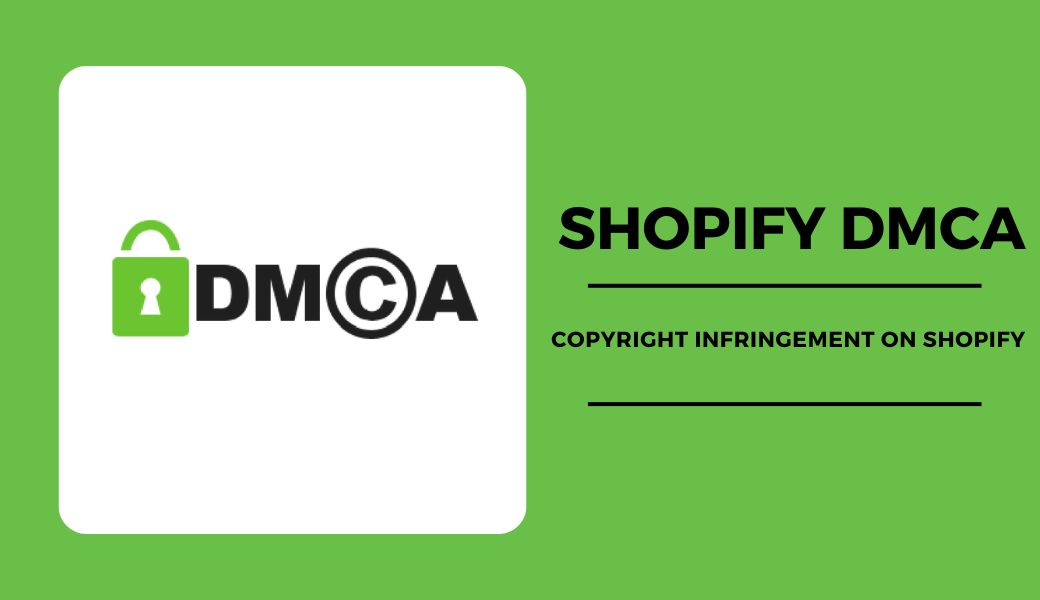Shopify is a brand-friendly ecommerce that allows brands to show off their merchandise and find their customers. But, with increasing popularity of this platform also raises a serious issue— infringement. This is where the Shopify DMCA right of action comes in.
In this blog, we are going to explore the field of copyright law which is a more complex area of law involved with Shopify, providing you with the essential knowledge and actionable steps to help you avoid any potential pitfalls.
Contents
- 1 What is Shopify DMCA and Why Does It Matter for Shopify Store Owners?
- 2 What does Shopify DMCA protect?
- 3 How does Shopify DMCA policy work?
- 4 File Shopify DMCA takedown notice
- 5 How to submit a Shopify DMCA Form
- 6 What happens when a Shopify DMCA takedown is not appropriate?
- 7 Alternatives to DMCA Takedowns
- 8 Best practices for Shopify store owners to avoid DMCA issues
- 9 FAQs: Shopify DMCA
- 10 Conclusion
What is Shopify DMCA and Why Does It Matter for Shopify Store Owners?
DMCA or Digital Millennium Copyright Act is a United States law that was enacted in 1998 to protect the intellectual property rights of the owners in the digital environment. As one of the most popular e-commerce platforms in the world with fast growth, more and more sellers are joining online businesses with Shopify, which leads to potential risks in infringement of intellectual property. To combat this issue, Shopify has implemented the Shopify DMCA system to protect its users through the DMCA copyright takedown notices. This is an effective way to address online copyright infringement while still protecting a fair marketplace, safeguards your business from legal problems and builds trust among creators.
In essence, Shopify DMCA concentrates on three main core matters including:
- Allows the owner of the copyright to create a notice and takedown system to inform Shopify about their suspicion of infringement or all infringing material. Consequently, that creation work can be taken down for investigation.
- By providing legal safeguards against unwanted access, it also enables copyright holders to have more access to their own creations in the digital realm.
- Giving false copyright management information, such as author names or copyright owners, is illegal under the DMCA. It also applies to situations in which the data is deleted or changed.
YOU SHOULDN’T MISS: Shopify 3 Months For $1 Plan 2024: How To Get And Open Your Store
What does Shopify DMCA protect?
Copyright infringement on Shopify
Shopify copyright infringement happens when your brand’s tangible works such as text, images, music, video, or software have been stolen and used without the proper authorization from the owner. The website forbids this, and a Shopify DMCA takedown of the offender website that uses your copyright content may be warranted.
Trademark infringement on Shopify
Shopify trademark infringement refers to the unauthorized use of a trademarked brand’s identity such as name, logo, slogan, design, products, and many more that belong to another brand. When a Shopify store or merchant uses your trademark that confuses customers about the origin of products or services, Shopify DMCA could be your “lawyer”.
Pay attention, here are some cases that belong to trademark infringement on Shopify:
- Your company’s name, logo, or design is used without permission, lead to misunderstanding about the brand identity.
- Your product design or packaging is similar to another brand’s products, even if unbranded, can imply a connection with that brand.
- Some merchants may use popular brand names as keywords to tag on their products to drive traffic. This can be considered as infringement if it misleads customers.
- Naming products or collections to famous or viral trademarks can create confusion about product origin.
Patent infringement on Shopify
Brand identification and market integrity are at risk due to the ease with which trademark infringement may happen in the digital sphere. Therefore, taking proactive steps to resolve and avoid such infringements is essential.
Shopify is a platform provider and typically doesn’t monitor individual products for patent compliance. However, if there is any claim from merchants about patent infringement, Shopify still joins to delete the infringing element, warn the store owner or even suspend the merchant’s account.
Patent infringement often happens in the context of selling or using these elements without the patent holder’s permission:
- List or sell patented product possessed by another company or individual without permission.
- Apply patented process or manufacturing method without permission, even if the end product looks different.
- Using patented technologies such as app functionalities, features, tools, without license.
How does Shopify DMCA policy work?
To address conflict related to intellectual property rights, the DMCA Shopify policy covers the following steps:
Step 1: Receiving DMCA Notices: The system accepts Shopify DMCA takedown notices from the owner. Remember, the valid notices must comply with the requirement of DMCA to be processed.
Step 2: Content Deletion: After investigation and verification, Shopify will remove or ban the allegedly infringing content. The decision will be delivered to the store owner and the “thief”. For some serious cases, “the thief” can be suspended.
Step 3: Notify the merchant: The store owner will receive a notification about the takedown. In case content was removed in error, the store owner will be offered a chance to file the counter-notice.
Did you know: How Does Shopify Work?
File Shopify DMCA takedown notice
To file DMCA notice, it is obligated to complete the standard DMCA format, including 4 sections:
Your contact information
No matter who you are, the copyright owner or authorized representative, when submitting the notice, it is essential to leave your information such as name, address, phone number, and email address. If you are a rightsholder, you are advised to use an email for infringement notices. The company name is optional but is advisable to provide since it helps identify ownership of the copyright.
Identify your work

This section is about the copyrighted work by the rightsholder, not the infringing one. The first half requires the owner to include the link of the original work or the URL of the product that has been used without permission. In the second half, Shopify states “This can be a representative list”, allowing the rightsholder to give a detailed description of the original work. Rightsholders are encouraged to complete this section comprehensively to ensure a fair and transparent adjustment.
The infringing work

Following the same format as the section above, this part also has 2 sections. The first one is where you place the link of the infringements and the second one is for a description. You will need to link separately each infringing content unless Shopify identifies the infringing work and takes action on it regardless they are the same.
Currently, Shopify allows the author to maximize 100 links in a single notice. Writing the description for the infringement is vital as it is where you demonstrate how and why that is an infringement. Shopify does not allow you to attach files or images of evidence, so write as comprehensively as you can.
Declarations and electronic signature
To accept the conditions of the submission, you must mark the three checkboxes in the last column. However, accepting the declaration has serious legal repercussions. A liability statement and the contact information provided may be shared with the infringer.
It is recommended that you carefully read the statements being agreed to, which include stating a good faith belief that the use of the copyright-protected work is not authorized under penalty of perjury. The reporter must enter their complete name as the “Electronic Signature” after checking the three boxes; the name must correspond to the information above. Click “Submit” to complete the process, and a notification will be issued to remove the infringing content.
You may concerned: What is Ghost Commerce and How Does It Work
How to submit a Shopify DMCA Form
Now, let’s go step-by-step on submitting a Shopify DMCA form. Here, we will guide you through 2 ways to file Shopify DMCA takedown notices.
Through Shopify’s Online DMCA Form
This is the fastest and easiest way to submit an alleged copyright infringement notice.
Step 1: Browse the Shopify online DMCA form
Step 2: You have to log in to take the next step
Step 3: Select “Report a Merchant”
Step 4: There is a list of reasons to file a report. Scroll down and choose “Copyright Infringement”
Step 5: Fill in all the essential information (as mentioned above) and click on “Submit”. You have sent the form successfully. Shopify will address and respond to you within 10 to 14 working days
Through Email
Sometimes the Shopify DMCA form is unapproachable. You can send a notice to Shopify’s designated agent according to the information below:
- Shopify Trust & Safety – Shopify Inc.
- Address: 151 O’Connor Street, Ground Floor, Ottawa, Ontario, K2P 2L8, Canada
- Email: legal@shopify.com
What happens when a Shopify DMCA takedown is not appropriate?
When a DMCA takedown Shopify is found to be inappropriate, such as when the claim is inaccurate, misleading, or intended to harass or unfairly target a competitor, here are some scenarios that may happen:
- First, the copyrighted work may be used for public purposes such as criticism, news reporting, teaching, commentary, research or scholarship. For instance, if a student uses a small percentage of your content, it will be considered fair use.
- Moreover, the usage could be allowed under the license’s conditions if you have been given one for your work. Before submitting a takedown request, always confirm any licensing agreements.
- For those who use a minor percentage of your work that does not lead to negative influence, this act may also not be justified as a DMCA takedown. For example, if your product appears in a wink in a video, it is not worth pursuing.
So, in this case, if the store owner believes that the takedown was issued in error, Shopify provides a counter-notice as a refutation. Store owners need to prove that the work does not infringe copyright or that they have rights to use it. It will take time to review the counter-notice. If the counter-notice meets DMCA requirements, the suspended content can be restored after 10 – 14 days on their website (if the counter-notice is accepted).
Read more: 10+ Best Dropshipping Suppliers for eCommerce
Alternatives to DMCA Takedowns
In many cases, Shopify DMCA takedown may not be the best solution to deal with copyright infringement. Thus, if you are in this situation, consider the following alternatives:
- Send a cease-and-desist letter to the infringer: Reach out to the infringing store and request them to stop using your copyrighted material, remove or modify their content. This solution is ideal when you want to resolve the matter directly and promptly without involving Shopify.
- Contact Shopify support directly: Shopify has a 24/7 support team to assist users in handling issues, especially disputes between copyright owners and store owners. Shopify may act on the matter if they see a clear policy violation, even without a DMCA claim.
- Seek legal advice: For some complicated cases or repeated infringements, contacting the infringer directly or utilizing Shopify support serves as a gentle reminder and leads to no remedy. Thus, do not hesitate to contact an intellectual property attorney to get more advice and smart legal remedies to make an end to the infringement.
Best practices for Shopify store owners to avoid DMCA issues
To avoid IP infringement on Shopify, store owners should:
This is the fundamental step before using any public “work” on your website. Store owners need to identify specific materials used in your store (do not miss out on any work, even the small pieces), reach out to the rightsholders, and beg for (or pay for) licensing agreements. By doing this, you are not only protecting yourself from potential legal issues but also expressing your respect to the author and ethical content use.
2. Use original content
Original content plays an important role in demonstrating your expertise and fostering close relationships with the audience. This approach helps you to drive more traffic and enhance engagement since customers are more likely to interact with original content that resonates with their interests. On the other hand, when adding user-generated content, it becomes crucial to comprehend creative commons licenses to make sure that these contributions adhere to copyright laws and safeguard the interests of all parties.
3. Educate your team and qualify content regularly
Training your crew in copyright laws, and consistently auditing content are key to patent management and person safety. Such understanding not only empowers features to navigate creative projects correctly but also helps create an organizational culture that respects intellectual property.
For example, providing extensive workshops and e-learning models can make employees more aware of their copyright responsibilities and dangers. Additionally, tools like CMS systems or copyright compliance software help track and identify content usage to its source so you can verify licensing status quickly. And, frequent audits and a subscription to current legal resources will also keep them on their toes and reduce chances of copyright infringement.
4. Respond promptly to DMCA notices
Website owners should reply to DMCA notifications promptly, as failure to comply could lead to copyright infringement liability due to circumvention of the safe harbor provisions of the DMCA.
Failing to adhere to these notices can have serious consequences, such as fines and the threat of a lawsuit from the copyright owner. You must realize that responding in a timely manner not only protects your legal position but also, in communicating that you intend to operate respectful environments for creators, may assist you in fostering a more protective atmosphere.
Having a straightforward process for reviewing and responding to DMCA requests is standard DMCA best practices, but also making sure all appropriate employees are trained on compliance and equipping your website to promptly take down infringing content when necessary are also part of appropriate DMCA practices. This step is a proactive one, which if taken, would greatly lower the risks and make their platform more reliable.
FAQs: Shopify DMCA
Who is authorized to file a DMCA Takedown Notice through Shopify?
They are the owner of the content described in the takedown notice or an authorized agent of the owner of the content described in the takedown notice.
Which content owners can file Shopify DMCA Takedown Notices?
If you are social media users and participants, copyright owners, content publishers or distributors (with permission of the content or copyright owners), code writers and publishers, NFT owners, you have the right to file Shopify DMCA notices.
How many DMCA takedown notices does Shopify allow?
Shopify does not set the limit for DMCA takedown notices that it would process. Nevertheless, if you receive DMCA notices repeatedly, your Shopify account may be suspended.
How long does it take to resolve DMCA notices?
The time depends on the complexity of the case, but it can take several weeks to months.
Conclusion
To conclude, Shopify DMCA is a vital solution to prevent illegal action of copyright intellectual property. As a seller on the Shopify platform, it is essential to understand about infringement to protect your brand. We hope that the information in this article will raise your awareness about intellectual property rights, help you to handle these issues appropriately and to continue to operate successfully on the Shopify platform.
Wish you happy and safe selling!




